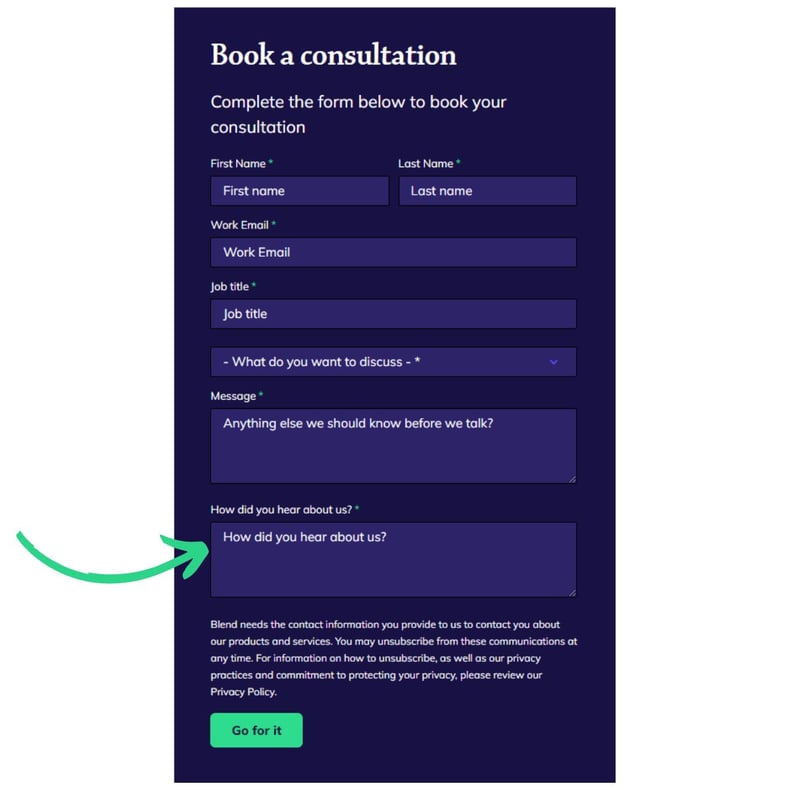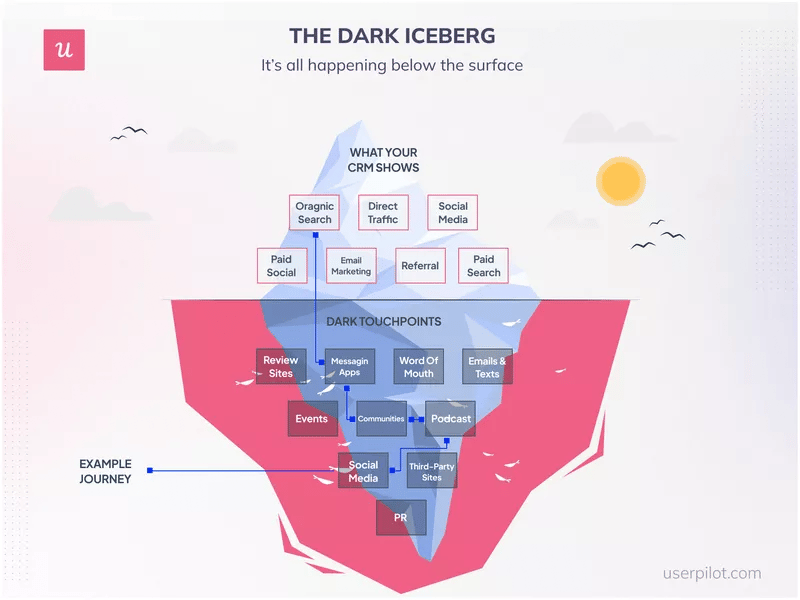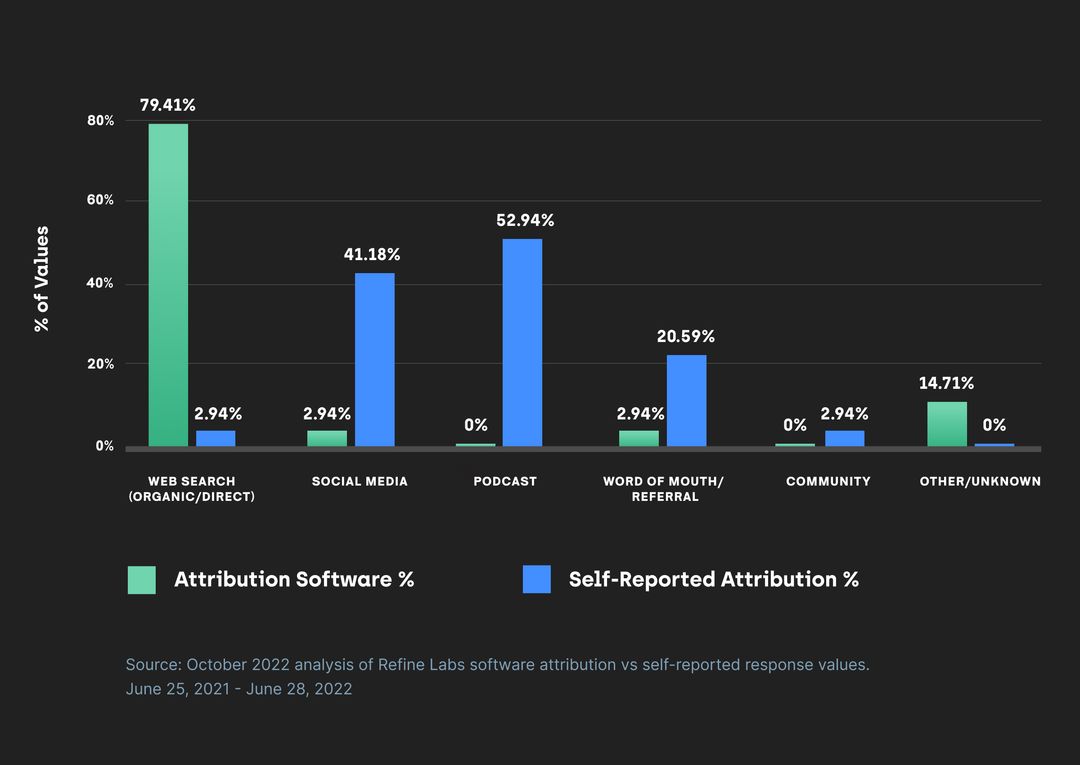Understanding how your marketing efforts influence revenue is crucial for any business looking to grow. That's why measurement and attribution are such important parts of modern marketing. However, traditional attribution models often fall short of capturing the full picture of customer behaviour.
Traditional models typically rely on website cookies to track touchpoints or engagement to assign credit for a conversion. But this ignores the complex, multi-channel journeys that many customers take before making a purchase.
That's where self-reported attribution comes in.
What is self-reported attribution?
Self-reported attribution is a marketing measurement that involves asking buyers how they heard about you on a high-intent form on your website. You can use this attribution method to understand the channels and touchpoints that generate demand for your business, including those your attribution software might not see. It’s a trustworthy data point as you hear exactly what the buyer is telling you, rather than what software attribution identifies.

The benefits of self-reported attribution
Self-reported attribution is a low-effort, high-impact strategy. Some of the benefits include:
- Often highlights ‘dark’ touchpoints that traditional software attribution can’t track.
- Gives you in-depth qualitative insight into what drives the most meaningful marketing conversions.
- Uncovers channels you had no idea were working for you.
- Understand your buyer’s preferred ways to self-educate and gather information.
- Gain a realistic view of your marketing efforts.
Chris Walker, CEO at Refine Labs, who pioneered self-reported attribution, summarises the benefits:
"You want to know how your prospects found you.
Who would’ve thought. The most accurate way to get attribution is simply by asking them!
The insights we’re getting from this are ground-breaking. And now we’re collecting this data at scale across 40+ SaaS companies so people can see what’s really going on."
Chris Walker, CEO, Refine Labs
Limitations of self-reported attribution
For all of its benefits, it’s important to acknowledge some potential drawbacks of self-reported attribution.
The main limitation is potential inaccuracy when answering ‘How did you hear about us?’. People often have recency bias, which means buyers may only remember the most recent or significant touchpoints with your business. And this might not be how they first heard about you.
Self-reported attribution is also extremely difficult to directly tie back to individual campaigns or ads unless the buyer tells you what exactly drove them to your website. It’s unlikely that they'll tell you they ‘searched for x keyword and clicked on your Google Ad’. In fact, you’re more likely to get a generic response such as ‘Google Ads’. So, it can miss a level of detail.
Self-reported attribution vs. software attribution
Whilst self-reported attribution relies on your buyers telling you how they heard about you, software attribution relies on cookies and tracking pixels to identify the interactions buyers have with your business.
The issue with software attribution
The fundamental issue with software attribution is that it simply doesn't have the capability to track ‘dark touchpoints’. Your software wouldn't know if somebody in my community mentioned you in a Slack conversation, right? There are endless channels that software attribution can't reach:
- Word of mouth
- Slack/discord communities
- Social media groups
- Podcasts
- Events
The inability to track dark touchpoints means that software attribution alone may not be able to accurately track all of the meaningful interactions buyers have with your business.
Vault GTM Research & Consulting's recent study confirms the measurement gap in software-based attribution.
The results show a 90% measurement gap in what software attribution credits versus what self-reported attribution credits.
In particular, attribution software either drastically under-reports or completely misses social media channels, podcasts, word of mouth, and communities altogether.
Software attribution encourages measurability over performance
Simply measuring attribution using software alone naturally encourages you to focus on/implement tactics that you can only measure with software, such as:
- Only posting links on social media as software-based attribution can’t track in-feed consumption.
- Using gated content to capture details as soon as possible, so you can measure campaign results.
- Only focus on distributing content in places that attribution software can measure, like your website and email.
Whilst you can use these tactics within a broader strategy, they don’t encompass all the other ‘dark’ touchpoints that buyers have, which align with how they educate, evaluate, and convert.
How to use software attribution effectively
Despite some flaws, software attribution is still a key component of measuring the buyer's journey. Software attribution tracks the source that the buyer used to get to your website. So by nature, it’s perfectly placed to identify the channels that buyers use when they’re looking to purchase a solution, such as:
- Organic search
- Paid search
- Referrals (such as review sites)
Once you've captured the initial conversion, software attribution can be a powerful way to track future, trackable interactions that buyers have on your website and with attributable marketing campaigns.
Combining self-reported and software attribution for ultimate insight
The debate between self-reported and software attribution isn’t an either-or decision. You can and should use both. Self-reported attribution is the best way to measure how demand is being created, even if that’s in an offline, untraceable channel. Software attribution is the best way to measure how you’re capturing demand in high-intent channels and tie this back to individual campaigns.
Start shedding light on dark touchpoints
Self-reported attribution provides a low-effort, high-impact way to gain insights into parts of the customer journey that your current attribution software will be blind to. Combining this with your existing attribution will give you powerful insights to make better-informed decisions.









